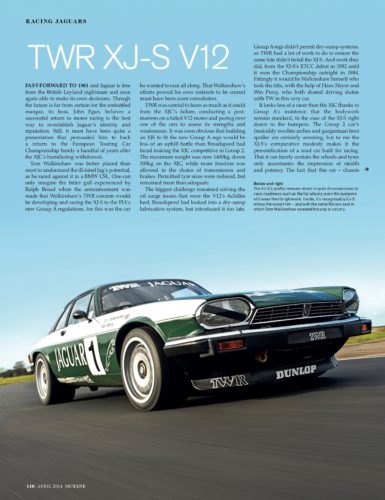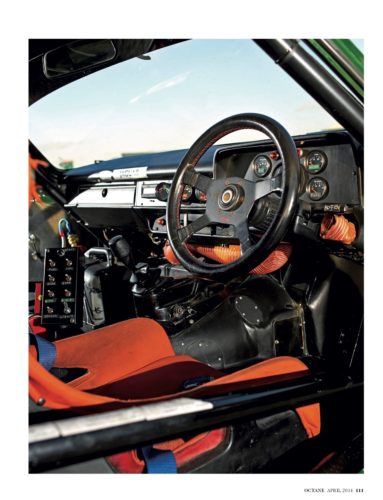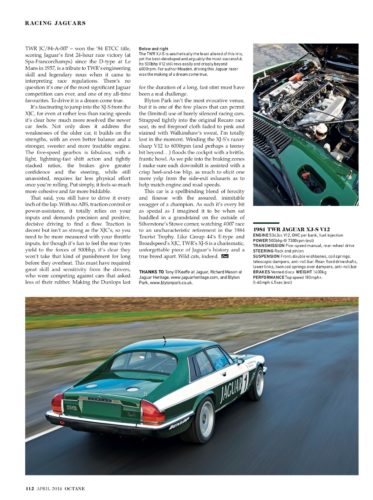RACING JAGUARS – TWR XJ-S V12
Reproduced with permission of Octane magazine (April 2014)

Octane April 2014 TWR XJ-S V12 Page 110
The XJ-S’s profile remains intact in spite of concessions to race-readiness such as fat wheels: even the bumpers still wear their brightwork.
FAST-FORWARD to 1981 and Jaguar is free from the British Leyland nightmare and once again able to make its own decisions. Though the future is far from certain for the embattled marque, it’s boss, John Egan, believes a successful return to motor racing is the best way to re-establish Jaguar’s identity and reputation. Still, it must have been quite a presentation that persuaded him to back a return to the European Touring Car Championship barely a handful of years after the XJC’s humiliating withdrawal.
Tom Walkinshaw was better placed than most to understand the ill-fated Jag’s potential, as he raced against it in a BMW CSL. One can only imagine the bitter gall experienced by Ralph Broad when the announcement was that Walkinshaw’s TWR concern would be developing and racing the XJ-S to the FIA’s new Group A regulations, this this was the car he wanted to race all along. That Walkinshaw’s efforts proved his own instincts to be correct must have been scant consolation.
TWR was careful to learn as much as it could from the XJC’s failure, conducting a post-mortem on a failed V12 motor and poring over one of the cars to assess its strengths and weaknesses. It was soon obvious that building an XJS to fit the new Group A regs would be less of an uphill battle than Broadspeed had faced making the XJC competitive in Group 2. The maximum weight was now 1,400 kg, down 300 kg on the XJC, while more freedom was allowed in the choice of transmission and brakes. Permitted tyre sizes were reduced, but remained more than adequate.
The biggest challenge remained solving the oil surge issues that were the V12’s Achilles heel. Broadspeed had looked into a dry-sump lubrications system, but introduced it too late. Group A regs didn’t permit dry-sump systems, so TWR had a lot of work to do to ensure the same fate didn’t befall the XJ-S. And work they did, from the XJ-S’s ETCC debut in 1982 until it won the Championship outright in 1984. Fittingly it would be Walkinshaw himself who took the title, with the help of Hans Heyer and Win Percy, who both shared driving duties with TW in this very car.

Octane April 2014 TWR XJ-S V12 Page 111
Inside, it’s recognisably XJ-S minus the wood trim – and with the same Recaro seat in which Tom Walkinshaw sweated his way to victory.
It looks less of a racer than the XJC thanks to Group A’s insistence that the bodywork remain standard, in the case of the XJ-S right down to the bumpers. The Group 2 car’s freakishly swollen arches and gargantuan boot spoiler are certainly arresting, but to me the XJ-S’s comparative modesty makes it the personification of a road car built for racing. That it can barely contain the wheels and tyres only accentuates the impression of stealth and potency. The fact that this car – chassis TWR JC/84-A-007 – won the ’84 ETCC title, scoring Jaguar’s first 24 hour race victory (at Spa-Francorchamps) since the D-type at Le Mans in 1957, is a tribute to TWR’s engineering skill and legendary nous when it came to interpreting race regulations. There’s no question it’s one of the most significant Jaguar competition cars ever, and one of my all-time favourites. To drive it is a dream come true.
It’s fascinating to jump into the XJ-S from the XJC, for even at rather less than racing speeds it’s clear how much more resolved the newer car feels. Not only does it address the weaknesses of the older car, it builds on the strengths, with an even better balance and a stronger, sweeter and more tractable engine. The five-speed gearbox is fabulous, with a light, lightning-fast shift action and tightly stacked ratios, the brakes give greater confidence and the steering, while still unassisted, requires far less physical effort once you’re rolling. Put simply, it feels so much more cohesive and far more biddable.
That said, you still have to drive it every inch of the lap. With no ABS, traction control or power-assistance, it totally relies on your inputs and demands precision and positive, decisive driving to find a flow. Traction is decent but isn’t as strong as the XJC’s, so you need to be more measured with your throttle inputs, for though it’s fun to feel the rear tyres yield to the forces of 500 bhp, it’s clear they won’t take that king of punishment for long before they overheat. This must have required great skill and sensitivity from the drivers, who were competing against cars that asked less of their rubber. Making the Dunlops last for the duration of a long, fast stint must have been a real challenge.
Blyton Park isn’t the most evocative venue, but it is one of the few places that can permit the (limited) use of barely silenced racing cars. Strapped tightly into the original Recaro race seats, its red fireproof cloth faded to pink and stained with Walkinshaw’s sweat, I’m totally lost in the moment. Winding the XJ-S’s razor-sharp V12 to 6,000 rpm (and perhaps a teensy bit beyond …) floods the cockpit with a brittle, frantic howl. As we pile into the braking zones I make sure each downshift is assisted with a crisp heel-and-toe blip, as much to elicit one more yelp from the side-exit exhausts as to help match engine and road speeds.

Octane April 2014 TWR XJ-S V12 Page 111
The TWR XJ-S 500 bhp V12 still revs
easily and crisply beyond 6000 rpm.
The car is a spellbinding blend of ferocity and finesse with the assured, inimitable swagger of a champion. As such it’s every bit as special as I imagined it to be when sat huddled in a grandstand on the outside of Silverstone’s Stow corner, watching #007 race to an uncharacteristic retirement in the 1984 Tourist Trophy. Like Group 44’s E-type and Broadspeed’s XJC, TWR’s XJ-S is a charismatic, unforgettable piece of Jaguar’s history and a true breed apart. Wild cats, indeed.
|
1981 TWR JAGUAR XJ-S V12 |
|
| ENGINE | 5,343 cc V12, OHC per bank, fuel injection |
| POWER | 500 bhp @7,300 rpm (est) |
| TRANSMISSION | Five-speed manual, rear-wheel drive |
| STEERING | Rack and pinion |
| SUSPENSION Front: | Double wishbones, coil springs, telescopic dampers, anti-roll bar |
| SUSPENSION Rear: | Fixed driveshafts, lower links, twin coil springs over dampers, anti-roll bar |
| BRAKES | Vented discs |
| WEIGHT | 1,400 kg |
| PERFORMANCE | Top speed 180 mph+ 0-60 mph 4.5 seconds (est) |
THANKS TO Tony O’Keeffe at Jaguar, Richard Mason at Jaguar Heritage and Blyton Park.